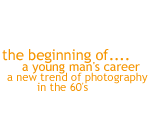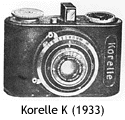

| home |
 
|
|
It was 1956, the Korean War was over and Japan was in an economic depression. Yoshihisa Maitani was the only one who joined the Camera Development Division of Olympus Optical Co. Ltd. During the first two years, he was mostly involved in familiarizing himself with the design process and with the company's factories. |
| The Olympus headquarters at that time was at Hatagaya, a backwater quite close to central Tokyo. It was a single two-storey ferro-concrete building. The Camera Development Division, which was formally called "Second Design Division" was located at the third floor in a single-room addition to the original building. Among the thirteen members of the Design Division, Maitani was the youngest. | ||
 |
||
|
After this, Maitani was asked
to design a cheap camera of 6,000Yen. Apart from the unique condition
of price, Maitani was left to his own devices. At that time the starting
wage for a university graduate was a little over 10,000Yen. Cameras were
generally considered as being very expensive items. The idea of designing
a 6,000Yen camera seemed to be an impossible mission. Maitani was expecting that it would come to nothing. However, after much thought and consideration, he decided to go head with the project. The workload was broken down into six tasks. It was designed to be completed one step at a time to reach the goal. |
||
|
Maitani:
"There was not the slightest doubt that if a 6,000Yen camera could really be made it would sell like hot cakes. But if it was that simple surely someone would have done it before me." "It's not a good idea to put all an engineer has into just one project. Being able to cut off some elements is crucial" |
||
 |
||
| By going back to the basics of "what a camera is?" Maitani realized that the problem was how to organize the basic elements of a camera - lens, shutter and diaphragm, into a medium that could take good pictures. From his experience in photography, he felt that taking pictures with a relaxed mind often produced good result. He intended to make the new camera as a secondary camera. | ||
|
Maitani:
"The Leica III f shutter button was ideal. One of its charms is the superb feeling you get when you place your finger on the shutter ring and press down so that the pad of your finger swells, and the action lightly clicks. Since the Pen was designed as a secondary camera for the Leica's user the timing goes wrong unless it has the same feeling." Akiko Takehara writes in Diary of Unique Finds-Olympus Pen, AXIS Jan-Feb 2001: The reason I'm interested in the Olympus Pen is its shutter button. The excitement I get when I have my index finger on the button, waiting for a chance to press it, rivals what I feel when I'm about to look at the photographs just back from the developers. That's why the response the instant I push the shutter is so important. The distribution of force when you click the shutter is similar to the Leica. |
||
|
Maitani decided that there wouldn't be any compromise on lens quality. The development expenses for the lens would never be limited. Conventionally, the only kind of lens that could be budgeted for a 6,000Yen camera would be a low resolution single element or two elements "doublet" type. However, Maitani insisted on a high class Zeiss Tessar type 4-element in 3-group lens. The entire lens unit was required to extend and retract in focusing. A wide angle lens was used to reduce focusing error. He begged Olympus lens designer Yoshisada Hayamizu to design the superb lens. In order to cut the cost of
the camera body, half -frame format was adopted. At that time color film was expensive. Maitani used to consume at least 7 or 8 roll of films at one time. The cost-cutting half frame format doubles the number of pictures. This matched his shooting style. Sony pocket transistor radios were beginning to grow popular at that time. He had a strong - and accurate - intuition that compactness would become the watchword of the age. The half frame format made a compact design possible. |
|
 |
In the camera history, half-frame cameras developed by other manufacturers were not a commercial success. Moreover, big and deluxe cameras that were filled with the latest features were the most popular models at that time. It was a gamble for a company to take up half frame camera, even a beginner like Maitani was able to understand this. Maitani confide his idea to his boss Eiichi Sakurai. Sakurai was an engineer with a great respect to originality. He told Maitani, "It sounds interesting. All right, we'll try it your way. But you'd better make sure it's good!" |
||
|
Another way to minimize the
cost was to eliminate gear wheels entirely. "Zero gear" was a new concept
in camera design. A regular design would utilize something like a hundred
gear wheels. |
|
Maitani:
|
||
 |
|||
|
Although film advance lever is the easiest to use, it is expensive and takes up a lot of space. A new film advance dial was developed. It is a coin-like disc with vertical grooves cut around the rim. It is hidden inside the camera with just a small part protruding at the rear. The principle of human engineering was applied in the design and positioning of the dial. This film advance dial combines the compactness and economy of a traditional film advance knob and the sensation and ease of use of a film advance lever. Initially, an outside industrial designer was assigned to the job of designing the camera's exterior. It turned out that the design did not meet with Maitani's requirement. Maitani then made his own design. He wanted it to have a high quality image. A camera that you can hang around with a Leica camera. |
|
|
Maitani worked enthusiastically at the new camera, and worked overtime for many months. He was on his own and could design the way he wanted. No senior engineers cared about him, they thought he could not design a 6,000 Yen camera. Five camera prototypes were made. Senior engineers were surprised and moved when they saw the prototypes. |
||
|
|
In October 1959, Maitani's first camera was released. It was called Pen and was a huge success.
|
|
Yoshisada
Hayamizu |
||||
 |
||||
| pen
1| pen 2 | another
perspective | scene
from the interview | literature
|
| chrono
| young Maitani | joining
Olympus | philosophy | anecdotes
l Maitani adv | Pen
|
OM | XA | photo
|